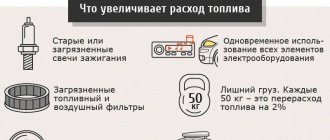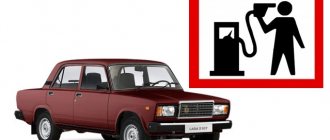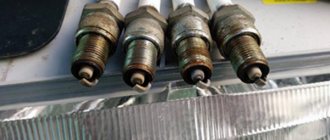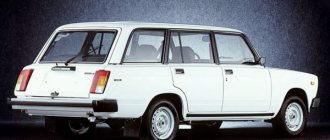VAZ
04/18/2017 1 Comment
- Oka 0.7 Fuel consumption rate Oka 0.7 l per 100 km
- Real reviews about Oka fuel consumption 0.8 l per 100 km
- Real fuel consumption Oka 1.0 l
The small car "Oka", developed in 1988 at VAZ, was supposed to become one of the most popular cars before the collapse of the USSR, but until 1994 it was produced in small batches, and since 1995, production was completely transferred to KamAZ and SeAZ. The peak of production began in 1998, when Oka began not only to be sold domestically, but also actively exported - due to the fall in the ruble exchange rate, its price in foreign currency turned out to be ridiculous. But the outdated design of the body and power unit did not allow the car to successfully compete with higher quality and reliable foreign analogues in the early 2000s, so its production was discontinued in 2008.
Fuel consumption on the VAZ-1111
Over the entire production period, more than 750 thousand cars were produced. This vase model has become truly popular. The cabin can accommodate 4 people with hand luggage. The trunk capacity is also quite acceptable for such dimensions. In the city, this is a very nimble and sneaky car, while the Oka's gas consumption made it affordable for families with average incomes. The car was relatively inexpensive and was very popular among city residents.
| Model | Consumption (highway) | Consumption (city) | Consumption (mixed cycle) |
| VAZ 1111 | 5.3 l/100 km | 6.5 l/100 km | 6 l/100 km |
Fuel consumption declared by the manufacturer
The technical documentation shows the following average fuel consumption for a VAZ1111 per 100 kilometers:
- on the highway - 5.3 liters;
- urban cycle - 6.5 liters;
- mixed cycle - 6 liters;
- idle speed – 0.5 liters;
- off-road travel – 7.8 liters.
Actual fuel consumption
The actual fuel consumption of the VAZ1111 on the highway and in the city is somewhat different from the declared one. The first Oka model was equipped with a 0.7 liter engine producing 28 horsepower. The highest speed that a car could reach was 110 km/h. It required 6.5 liters of fuel per 100 kilometers when driving in the city and about 5 liters on the highway.
In 1995, a new Oka model went into production. The technical characteristics of the engine have changed, the operating speed has decreased. The power of the new two-cylinder engine was 34 horsepower, and its volume increased to 0.8 liters. The car accelerated to 130 km/h. The average gasoline consumption of the Oka in the city was 7.3 liters per hundred kilometers and 5 liters when driving on the highway.
In 2001, the developers tried to further improve the power qualities of the popular small car. The production of a new model with a 1-liter engine has begun. The power of the unit was significantly increased. Now it amounted to 50 horsepower, the maximum speed figures reached 155 km/h. Gasoline consumption rates for the latest Oka model were left at an economical level:
- in the city – 6.3 liters;
- on the highway - 4.5 liters;
- mixed cycle - 5 liters.
In general, over the more than twenty-year history of the car, a large number of models have been produced. The most significant were some socially oriented versions of cars, cars for disabled people and people with disabilities. Sports interpretations of the car were also produced.
They were equipped with a more powerful engine and reinforced chassis.
Oka 0.7
From the very beginning, a VAZ-1111 micro-displacement carburetor engine with a volume of 649 cm3 was developed for the Oka. This two-cylinder engine was capable of developing a power of 30 hp. and reach a torque of 45 Nm. The engine was paired with a 4-speed manual transmission.
Oka fuel consumption rate is 0.7 l per 100 km
- Maxim, Ufa. I have an Oka VAZ-1111, manufactured in 1994. Despite its unpresentable appearance, the car is not bad and suits me 100%. For its weight, the engine power is quite enough. By the way, consumption in the city is quite normal - 5-7 liters, but on the highway, if you drive too hard, sometimes it can reach 10 liters.
- Timur, Ryazan. I took it literally for a couple of years - it was stupid to learn how to drive. Even if I knock or break it, I don’t mind at all. However, everything turned out to be not as sad as I thought. It drives and that’s the main thing, although it doesn’t even smell like comfort. The average consumption is 6 liters – which is a lot for the tiny volume under the hood.
- Georgy, Tambov. Oka is my first car. I got it from my dad, and before that it had been sitting in the garage for five years and was rusting. Of the advantages, I will only note its unpretentiousness and the fact that it is the same Lada, only neutered and trimmed down. Gasoline consumption with a normally adjusted carburetor is 6 liters in the city, more on the highway, because the gearbox is 4-speed and at more than 90 km/h it eats gasoline like a cow.
- Irina, Rostov. When I decided to learn to drive a car, I went to a driving school, after which my father finally entrusted me with his car - a 1992 Oka. At that time, for me it was just something - but now I understand that the car was an outright log and not worth a good word. It broke down constantly, the consumption in the city was no less than 6 liters, I now have this consumption on my Hyundai with an engine 2.5 times more and 3 times more powerful.
- Sergey, Moscow. At one time, I rode a 1993 Oka for about a year and a half. This was in 2008 - I needed wheels, but there was no money, so I took an Oka, which at that time cost me about $300 - just ridiculous money. I’ll tell you that in fact everything is not as bad as it seems - if we put aside emotions, demands for comfort and all that, then this car fulfills its main purpose of transporting you from point A to point B 100%, and nothing more. need to. Consumption in the city is on average 6.5 liters, and it is generally undemanding when it comes to the quality of gasoline.
A little history
At first, the car was positioned as a people's car, and it was going to be produced in a huge industrial complex in Yelabuga. Thus, it was planned to put an end to the automobile shortage that had been observed in the country for many years. However, the plans were never implemented, and Oka in the mid-1990s was transferred to SeAZ, whose factories became part of AvtoVAZ, and KamAZ.
Specifications
It’s not difficult to calculate the Oka’s fuel consumption if you know what kind of engine is installed inside. This is a carburetor engine with a capacity of 649 cc, 30 l/s. This is half of the V8 engine (VAZ-2108). Some other components were taken from another model, VAZ-2105, for example heating fittings, faucet, radiator. This partially solves the problem with spare parts, but some parts (for example, the crankshaft) are original, so, given the small scale of production, the price for them may exceed the cost of similar parts for other domestic cars. This is worth taking into account when purchasing, since the low fuel consumption of the Oka will bring savings, but perhaps only until the first major repair.
Oka in numbers
- Front tires – 135/80, R12.
- Rear tires – 135/80, R12.
- Transmission – manual gearbox.
- Fuel consumption of the VAZ-1111 “Oka” is 4.7 l (in the city). In the basic version of SeAZ-11116 - 5.5 liters, in the basic version 11113 - 6.8.
- Fuel - AI-92 gasoline.
- Ground clearance – 150 mm.
- Number of seats – 4 seats.
- Drive – front (FF).
- Number of doors – 3 doors.
- Engine capacity – 0.7 l.
- Power – 33 hp
- Trunk volume – 210 l.
- Fuel tank volume – 30 l.
How to reduce fuel consumption
VAZ OKA fuel consumption per 100 km depends on the engine type, unit size, transmission type, year of manufacture of the vehicle, mileage and many other factors. For example, in the winter season, the average gasoline consumption of an Oka in the city and when driving outside the city limits will be slightly higher than in the summer under the same operating conditions of the vehicle.
It is important to pay attention to the technical characteristics of the VAZ 1111 OKA, fuel consumption if unbalanced can increase significantly.
- The indicator button under the panel may be recessed, there is no indicator signal, and the choke does not open completely.
- The solenoid valve does not fit tightly.
- The jets are not suitable for the size and type of model
- The carburetor is clogged.
- The ignition is set poorly.
- The tires are underinflated or, conversely, the tires are overinflated.
- The engine is worn out and requires replacement with a new engine or major overhaul of the old one.
It is also worth remembering that increased fuel consumption by a car may depend on other factors other than the technical condition of the carburetor and the car as a whole.
The aerodynamics of the body, the condition of the tires and road surface, the presence of heavy bulky cargo in the trunk - all this will affect the fuel consumption figures.
Fuel consumption largely depends on the driver himself and the driving style of the vehicle. Drivers with extensive driving experience know that driving should be smooth, without sudden braking or acceleration.
Owner reviews on gasoline consumption
Alexander from Irkutsk. I am the owner of a VAZ 1111 (Oka) produced in 1993. Of course, the appearance is not very nice, but I like the reliability and performance. Light weight, powerful engine. As for consumption, in the city I get 5.2-6.8 liters per hundred, and on the highway up to 10, if I drive hard.
Maxim from Oboyan. I bought a used OKU in 1997 with a 0.8 liter engine and a mileage of 50 thousand. Replaced all consumables, slightly repaired the suspension and made the car look like new. Consumption in the city is a bit high – 7.1-7.8 liters, and on the highway it’s a liter less.
Stanislav from Yalta. Inherited OKA 11113 with a Chinese liter engine. The car is not serious, but it is enough for trips to the country and occasional transportation of small cargo. Probably the only plus is consumption: it consumes 6 liters in the city, and 5.5 on the highway.
Speed characteristics of a minicar
When driving outside the city, the Oka is quite capable of accelerating to 110 km/h, however, as the owners note, the ride becomes quite uncomfortable. The steering wheel tries to jump out of your hands, you have to constantly squeeze it very tightly. The suspension senses the slightest unevenness in the road surface and instantly transmits them to the driver’s “fifth point.” This is not surprising; with such small wheels (12 inches), it is simply impossible to drive through the pits in any other way.
Users named another drawback as the difficulty in finding spare parts when making repairs, and this machine breaks down quite often. Today, such minicars are no longer produced, and therefore sales of parts have stopped. Of course, in such cases it is much easier for a Russian car enthusiast than for a foreigner caught in a similar situation. Our craftsmen themselves have learned to make spare parts needed for repairs, but it is not always possible to find and process truly high-quality metal. Therefore, long-manufactured parts rarely last.
Continuing the topic of shortcomings, it is worth mentioning that the first breakdowns for the owners began after only a year and a half of operation, and everything began to “crumble” at once. The biggest problems were caused by ruptures in the stove pipes and thresholds that were not resistant to corrosion. Those who were particularly unlucky with the body had to digest them twice a year. However, in fairness, it is worth noting that if the owner was meticulous and closely monitored the car, the Oka was capable of driving up to 100,000 km. There are quite a lot of such cars on Russian roads now. And they run quite briskly.
On the subject: Rosa First Lady: description, photo. How to grow First Lady in your garden
Lada Oka 2003 - owner review
| Year of issue: | 2003 |
| Body type: | Hatchback |
| Transmission: | mechanical |
| Drive unit: | front |
| Generation: | 1st generation |
| Engine: | gasoline, 700 cc, 33 hp |
| Fuel consumption on the highway: | 6.0 l/100km |
| Fuel consumption in the city: | 5.0 l/100km |
| Year of purchase: | 2019 |
| Mileage: | 49,900 km |
| Steering wheel: | Left |
I decided to write a review about this sewing machine.
I was looking for an inexpensive, simple and economical car for commuting to work, because... Cedric is still swallowed, and the prices for Japanese spare parts are becoming more expensive. The budget was initially 35 thousand rubles, but had to be raised to 50. I watched 8s and 9s. Sorry sight. Awful rottenness, a bunch of owners, a murky history, prohibitions.
Extremely upset by the last inspection, I scored the last okushka, which was hanging for 50 thousand rubles. According to the photo it is also in excellent condition. The seller said that he could not start it yet after a long period of inactivity. We agreed that as soon as he sorted out the launch, he would call me. A couple of days later we called and scheduled a viewing. When I saw it, I immediately decided that this was it.
Moray eel color. KAMAZ assembly. Equipped with a cigarette lighter, electric headlight adjustment and right mirror. This is almost the most luxurious version! Just kidding, of course











